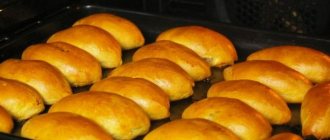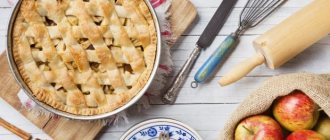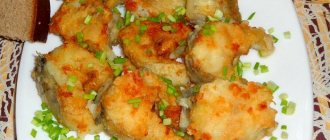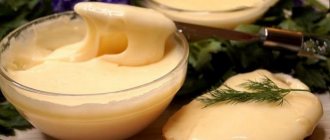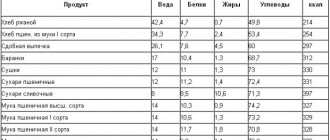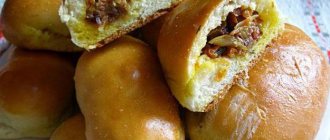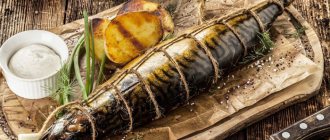Publication in the group: Calorie content, composition of food products
Pirozhki is a traditional dish of Russian cuisine. There are many options for fillings for pies: cabbage, potatoes, mushrooms, cheese, jam. However, the high calorie content of pies in most cases forces weight watchers to limit their consumption or completely abandon them.
The article will discuss whether it is possible to eat pies while on a diet, what are the benefits and harms of such food, and how to make pies not only tasty, but also healthy.
Are there any benefits from cabbage pies?
The benefits that any baked product brings to the body are very conditional. The main advantage of such a snack is the ability to quickly satisfy hunger and saturate the body with energy for a long time.
However, it should be understood that the body instantly receives energy by breaking down fast carbohydrates, which such baked goods are rich in and which are not very healthy. Therefore, you should not eat pies every day, preferably in the first half of the day, to avoid problems with excess weight.
Ingredients of a pie with cabbage
A pie with cabbage, which is quite high in calories, is made from flour dough and cabbage. The dough can be prepared with yeast or kefir. The cabbage is pre-simmered in oil so that it is soft, juicy and crispy. If the pie is fried in a frying pan or deep-fried, then the calorie content of such baking increases. Therefore, it is better to bake the pies in the oven rather than fry them in a frying pan in a lot of oil.
The calorie content of fried pies will be slightly higher than those baked in the oven.
Pies, like any other food, contain minerals and vitamins:
| Microelement | % of daily value in 100 g daily value |
| vitamin A | 22,4 |
| vitamin B1 | 35 |
| vitamin B2 | 35 |
| vitamin C | 12,4 |
| vitamin E | 24 |
| chlorine | 12,2 |
| cobalt | 23,5 |
| manganese | 19,5 |
| molybdenum | 13,6 |
Composition in calories of baked and fried pies, percentage of daily value
The calorie content of fried pies will be slightly higher than those baked in the oven.
To prepare both baked and fried pies, the same ingredients are used:
- water;
- wheat flour;
- butter or margarine;
- yeast (dry or fresh) or kefir;
- eggs;
- sugar;
- salt;
- cabbage
Lean pies do not contain butter or margarine, which somewhat reduces the calorie content.
Nutritional value 1 pc.
The nutritional value of 1 baked pie weighing approximately 90 g is 214 kcal. The calorie content of a fried pie with the same weight will be about 257 kcal. If we take the daily intake as an average of 2000 kcal, then the percentage of the daily intake of 1 pie baked in the oven is about 11%. For a fried pie with cabbage, this figure will be 12.85%.
Nutritional value per 100 g
The nutritional value of 100 g of baked pies is 243.6 kcal (12.18% of the daily value). The nutritional value of 100 g of fried pies is 286 kcal (14.3% of the daily value). It turns out that by eating 4-5 pieces of both fried and baked pies with cabbage a day, a person receives more than half of his daily calories.
How many calories are in a fried or baked pie with different fillings?
Pirozhki is a traditional Russian dish, a flour product whose main components are a dough shell and a fruit/vegetable/meat filling.
It can be made from puff pastry, yeast-free and yeast dough made from different types of flour and grinding. The energy value also depends on the type of filling and method of preparation. Calorie tables will help you easily determine how many calories are in a particular type of pie. WEIGHT LOSS STORIES OF STARS!
Irina Pegova shocked everyone with her weight loss recipe: “I lost 27 kg and continue to lose weight, I just brew it at night. » Read more >>
Baked pies cooked in the oven are lower in calories.
Calorie content depending on filling:
According to the table, a product with chicken has a higher calorie content than one stuffed with meat or liver.
It is necessary to compare not only the energy values of products, but also the BZHU indicator (the ratio of proteins, fats and carbohydrates).
Chicken fillet is high in protein, which is important for the development of muscle tissue. In this case, weight gain will be achieved through muscle growth. And animal meat contains more fats - they cause the formation of unwanted deposits on the sides.
The oil used for frying pies has high energy value due to its high fat content. Therefore, products cooked in oil are higher in calories compared to those baked in the oven. Energy value of different fillings:
These figures exceed those served in fast food restaurants. For example, with an average calorie content of a fried pie of 230 kcal per 100 grams, a cherry pie from the McDonald's chain has the same energy value, although it weighs almost 2 times less - 230 kcal per 60 grams (1 piece).
Abuse of flour products fried in oil leads to fullness and disruption of the digestive system.
During the period of weight correction, it is recommended to give preference to baked goods made from yeast-free dough filled with vegetables and a light side dish: of all those presented in the tables, they are the least high in calories. For example, when eating a small pie with cabbage, sorrel, egg and onion, the body will receive about 150-170 kcal - this should be the average snack between lunch and dinner. The BJU indicator in such dishes is close to the norm: the vegetables in the fillings are rich in fiber, vitamins and amino acids. This light, low-fat food is well absorbed by the body and nourishes it.
The heaviest are fried products with meat, mushrooms, fish and rice. You should avoid such dishes during a diet, because the oils and simple carbohydrates in their composition do not saturate the body, but are deposited on the body in the form of fat.
Homemade baking is healthier, so it is recommended to make diet pies yourself. When preparing a dish in this way, it is convenient to control its composition, saturation with proteins, fats and carbohydrates, which is important when losing weight.
Some cooking tips:
- Way. The diet excludes foods fried in oil. Therefore, the dish must be cooked in the oven. If necessary, the filling is pre-steamed or boiled (in the case of meat and vegetables).
- Flour. The coarsely ground product contains all the components of the grain, and therefore retains its biological value for the human body. The calorie content of bran and rye flour is lower than that of wheat.
- Filling. It should include fresh natural products. You should avoid animal meat and frozen semi-finished products. It is recommended to give preference to poultry: chicken or turkey fillets are easily digestible foods rich in dietary fiber and protein. You can supplement the composition with different types of greens, tomatoes, bell peppers and cheese. Makes a very nutritious and healthy snack.
- Spices. Salt and pepper should be used to a minimum, and herbs and spices should be completely excluded from the recipe. Spicy and salty foods make you want to take more, while bland foods make you feel full right away.
Proteins fats carbohydrates
A cabbage pie, which is quite high in calories, has the following BJU composition (for pies cooked in the oven):
| Weight, g | Proteins, g | Fats, g | Carbohydrates, g | Kcal | |
| In 1 pie | 90 | 4,4 | 7,1 | 33,6 | 214,1 |
| In 100 g of pies | 100 | 5 | 8,1 | 38,2 | 243,6 |
For fried pies, the fat content will be higher, which accordingly increases their calorie content.
Dependence of calorie content on pies filling
A pie with cabbage, which is high in calories, is far from the most satisfying among similar baked goods. So pies with meat filling will be much more nutritious. Regardless of the type of minced meat, any meat has great nutritional value. Therefore, the calorie content of such pies will vary from 260 to 350 kcal.
Pies filled with vegetables, herbs or onions are “lighter” than meat or fish ones. The calorie content of such vegetable pies varies from 148 to 255 kcal.
Stewed cabbage is the lowest calorie filling.
Vegetable filling as a share of the calorie content of pies ranges from 19 to 45 kcal. At the same time, stewed cabbage is considered the lowest-calorie filling. But fillings with cabbage in combination with mushrooms or eggs will be more filling and, accordingly, higher in calories. Also, a lot depends on the cooking method. When cooked in the oven, the resulting nutritional value of the product is lower.
Calorie content of pies
Since ancient times, among sweet breads and not so baked goods, loaves and pies have occupied a special place in the cuisine of the Slavic peoples. Baked with a wide variety of fillings, from fish and meat to cabbage, carrot or apple, they became both a festive table decoration and a pleasant addition to tea. And today the demand for them does not subside: from quick variations that can save the day when guests unexpectedly arrive, to real culinary masterpieces that are the results of many hours of work - pies have rightfully become almost the central link in baked goods. But, like any baked goods, they pose a certain threat to the figure, especially if there is no sense of proportion in consumption. In this case, everyone who stands guard over beauty and slimness should know how many calories are in the pie, what they depend on, where they go, how they are absorbed, where they are stored and, most importantly, how they can be reduced. After all, even when on a diet, sometimes you want to pamper yourself without compromising the results.
How many calories are in a pie
The number of recipes for pies has long exceeded a hundred, and therefore it is not possible to consider each of them for calorie content. But it is possible to identify several patterns, without which not a single pie can do, and consider the “weight” of the finished dish based on them. And the very first, of course, is the dough. After all, it bears the main load; it determines the texture of the future product, as well as the calorie content of the pie. It will then be with fish, carrots, eggs and onions, or even with cottage cheese - it’s not so important. But more than half of the success depends on the choice of test. There are three main types of pie dough: classic yeast, yeast-free and chopped.
Regular yeast dough is most popular among those who bake pies and pies, and it is used mainly for closed-type products. This dough consists of dry or raw yeast, milk, sugar, eggs and flour, and has a calorie content of 225 kcal per hundred grams. It is precisely this “base” of pies, pies, buns, kulebyak and bread that is considered the most dangerous for the figure: the expression “swept away by leaps and bounds” was not taken out of thin air. By and large, there are no useful ingredients in it: wheat flour is refined to the point where almost nothing remains in it except the very kernel of the wheat grain; sugar, again, if it is not brown, but white, belongs to the group "empty" products. Positive aspects can be noted in the yeast itself, which contains a large proportion of protein, vitamin B, as well as PP, folic acid and other trace elements. Yeast is actively recommended for joint diseases, especially when there is a deficiency of joint fluid. They can even affect the level of cholesterol in the blood, but at the same time they are quite dangerous for the figure. Perhaps for this reason, previously, yeast dough was kneaded only on holidays, as a kind of departure from strict food. And now those who are losing weight or want to stay slim should not abuse products made from it in order to avoid weight gain. For example, the calorie content for a cabbage pie made with yeast dough will be as much as 174 kcal per hundred grams. Moreover, there is still a relieving aspect here - cabbage: the product is quite dietary and useful as a metabolic stimulant. If, for example, you replace it with something less light, the same minced meat, which, of course, is healthy, but still takes much longer to digest than vegetables, in contrast to a pie with cabbage, its calorie content will already be 305 kcal for the same volume. And a yeast apple pie will have a calorie content of 308 kcal.
Yeast-free dough, contrary to possible assumptions, cannot boast of a lower calorie content, but its harm from a nutritional point of view is somewhat less. Of course, this is considered in relation to flour products in general, and not in comparison, for example, with vegetables and fruits. With all the variety of yeast-free dough: puff pastry, shortbread, choux pastry, unleavened pastry, chopped – for pies, preference is given to the last two variations. The first is good for various kinds of puff pastries, the second – for cookies and tartlets, the third – for profiteroles.
Unleavened pastry is made using flour, sour cream or kefir, sugar, eggs and possibly a small amount of butter. The amount of sugar depends on what kind of filling will subsequently be in the pie: for meat, fish and vegetables, they usually take very little, but for cottage cheese or fruit - much more. The calorie content of such a dough ranges from 305 to 241 kcal, depending on the proportions of its ingredients. Here, again, the benefits are relative, since they can only be extracted from butter, sour cream, kefir or milk, as well as from eggs. But it is worth remembering that if you are too enthusiastic, it will turn into harm: both for the liver and pancreas, and for the figure. The calorie content of a pie with cabbage on unleavened pastry will be 157 kcal, but for an apple pie the calorie content will be only 168 kcal for the same hundred grams.
Another option, which is most often used in open pies, is chopped dough, whose composition is slightly different from unleavened dough. There is no sour cream, kefir or milk here: the base is butter with sugar, flour and egg. This dough is kneaded very quickly and placed in the refrigerator for half an hour to an hour. In its consistency, it resembles soft shortbread, because, unlike the latter, it does not break when you try to cut it. Its benefits, of course, are questionable, and the fat content due to the amount of butter is higher than that of previous types, but this type of dough is usually used less than others: the lion's share of the dish is filled. The most popular of these are open apple pie with a calorie content of 218 kcal or the same cottage cheese pie with a calorie content of 330 kcal per hundred grams.
You can also find pies made from puff pastry, although it is mainly used for various envelopes, bagels and the like. Such dough, of course, cannot be called “harmless” due to the high proportion of butter, which provides both fat content and calorie content to the pie or other product made from it. But there are no eggs in it, which somewhat reduces the “weight” of the dish. As a result, the calorie content of the puff pastry itself is approximately 244 kcal per hundred grams.
Pies in the diet of those watching their figure
After studying how many calories are in the pie, we can regretfully state that this dish is not at all dietary. No matter how much you would like to, you won’t be able to lose weight with it. However, this is not yet a reason to completely abandon pies as such. It’s enough just to choose the right dough and filling, giving preference to unleavened butter dough that you knead yourself. Then you won’t be able to put in so much sugar, use sour cream with a lower percentage of fat content, and don’t overdo it with butter.
In addition, from the point of view of reducing harm from the rather high calorie content of a pie - apple, fish, cottage cheese or meat - you should introduce this dish into your diet not often and try to eat it in the first half of the day, when the metabolism is at its highest. Then, during the day, through physical activity, you will be able to “atone for guilt” and burn the calories you have eaten from the pie, not allowing them to be deposited in problem areas.
pohudeyka.net
Correct usage
The calorie content of such a product will not contribute to weight loss in any way, especially if consumed regularly. This applies not only to cabbage filling, but also to all others, since the calorie content of yeast dough, puff pastry and even kefir dough is high.
There is no need to completely give up pies. You are allowed to consume this product no more than 1-2 times a week if you are not overweight. It's better to do this in the morning, for breakfast. You can eat 1 pie without harming your figure. At the same time, it is important to monitor the amount of calories entering the body from other foods during the day.
Variant of pie with Chinese cabbage
Those whose digestion is not too kind to white cabbage due to its coarse fiber should pay attention to this recipe. It uses Chinese cabbage, which is more tender and does not put a strain on the gastrointestinal tract.
Ingredients:
- Chinese cabbage - 1 medium-sized head;
- chicken eggs - 3 pcs.;
- onion - 1 head;
- garlic cloves - 5 pieces;
- salt and pepper - to taste;
- butter for frying.
The process of making low-calorie Chinese cabbage pie:
- Chop the Chinese cabbage very finely along with the onions and garlic cloves.
- First fry the garlic and onion in butter, then add the cabbage. Heat treatment should not be too long - 5 minutes will be enough.
- Then take any suitable dough option - kefir or vegetable oil - and prepare a closed pie. Bake it until a golden brown crust appears on top of the dough.
Variations on the theme of cabbage pie
Sometimes, if you need to whip up a cabbage pie, you can use recipes that do not contain the dough itself. This will allow you to quickly prepare a full-fledged dish, while the taste will be excellent every time.
The harm of pies with cabbage
Most nutritionists are unanimous in the opinion that any pies, including those with cabbage, are harmful.
In addition to the high calorie content and instant saturation of the body with fast carbohydrates, experts note such negative aspects that arise when consuming this food, such as:
- lack of nutrients - the patty contains some useful substances, but during cooking most of the important microelements disintegrate, especially if the patties are fried in oil;
- high cholesterol content – the dough itself is a source of cholesterol, and going through all stages of processing during frying, the content of this harmful substance increases significantly, especially when deep-frying. Eating such foods for a long time leads to the formation of plaques (cholesterol deposits) on the blood vessels and problems with the body’s cardiovascular system;
- disturbances in the functioning of the gastrointestinal tract - any fresh baked goods are considered difficult to digest food, not to mention pies fried in a frying pan in oil. All baked goods take a long time and are difficult to digest and require significant energy consumption from the body. With frequent consumption of pies with cabbage or other filling, the gastrointestinal tract becomes overloaded and the person suffers from bloating and heaviness in the abdomen;
- the presence of carcinogens in the composition - this applies to pies fried in a frying pan in a large amount of oil. During such processing, under the influence of high temperatures, special reactions occur that lead to the release of harmful radicals. Excessive consumption of fried foods greatly increases the risk of developing cancer.
How to reduce the calorie content of pies?
In order to reduce the calorie content of the finished cabbage pie at the end, you should approach the process of preparing the dough and filling in a non-trivial way:
- cabbage itself is low in calories, but when stewed in sunflower oil it becomes much more filling and harder to digest. It is better to use olive oil instead of sunflower oil, or bake the cabbage in a sleeve in its own juice and then chop it for filling;
- instead of yeast dough, it is better to make dough with low-fat kefir;
- To prepare the dough, in addition to wheat flour, they take another, more healthy one - buckwheat, oatmeal, corn. It will not be possible to completely replace wheat flour with them, since the baked goods will not rise, but they will partially reduce the calorie content of the finished pie;
- When kneading the dough, you should not add trans fats (margarine), as this is very harmful;
- for dietary baking, do not add butter to the dough;
- frying pies in oil is strictly not recommended; pies should be baked in the oven, while the baking sheet is covered with parchment and minimally greased with butter;
- There is no need to brush the top of the pies with egg, this will add extra calories to the product.
PP pie with cabbage and egg
For this recipe, you can take any dough - with vegetable oil or kefir. But the following components are prepared for the filling:
- sauerkraut - 500 g;
- onion or leek - 100 g;
- boiled eggs - 2-3 pcs.;
- salt and ground black pepper to taste;
- butter - 10 g.
This PP pie with cabbage will require the following steps:
- Boil the eggs hard and chop them.
- Rinse sauerkraut in boiled water to reduce acidity.
- Chop the onion and mix with cabbage.
- Simmer in a frying pan with 10 g of butter.
- While preparing the filling, add salt and pepper.
- Then place some of the dough into the container where the pie will be baked. Distribute the cabbage and onion filling. Place chopped egg on top.
- Cover with the second part of the dough and secure the edges tightly, turning them up.
- Baking will last approximately 35-40 minutes at 200-220 °C.
Various filling options for cabbage pies
Based on two types of dough that help you eat right, you can make a wide variety of cabbage pies. The filling allows you to experiment, each time producing dishes with different taste qualities.
Tips for losing weight
A pie with cabbage is not the best food option for those who want to lose weight. The abundance of calories and carbohydrates contained in baked goods will significantly slow down this process. You can include such high-calorie dishes in your diet if you have high physical activity. It is advisable to eat pies for breakfast, since the calories that enter the body before lunch are completely consumed by the body and are not stored as fat deposits.
We should not forget about the norm - it is allowed to have 1 pie for breakfast 1-2 times a week. As described above, it is better to give preference to pies prepared in the oven according to recipes that do not include butter or margarine. Since it is difficult to buy relatively “healthy” pies without harmful additives in the store, they are prepared independently.
Options for preparing dietary cabbage pies and their calorie content
To diversify your diet, in addition to one-ingredient pies with cabbage filling, you can experiment and combine cabbage with various ingredients. It can be minced meat, eggs, fish, mushrooms. To ensure that the calorie content of the pies does not increase significantly when adding other ingredients, the dough should be prepared without yeast, for example with kefir, and the pies should be baked in the oven rather than fried. The filling for pies should also be added minimally.
With stewed cabbage
To prepare you will need:
- 350 g wheat flour;
- kefir 1% - 250 ml;
- cabbage (medium head) - 1 pc.;
- soda – 0.5 tsp;
- salt – 0.5 tsp.
Preparation progress:
- Pour kefir into a bowl, add salt and soda. Mix everything thoroughly and let stand for a few minutes until foam appears.
- The flour is sifted and combined with kefir, stirring well so that no lumps form.
- Shred the cabbage and simmer over low heat until half cooked. Salt the filling at the end, so it will retain more juiciness.
- The dough is divided into 10-12 approximately equal parts. Roll out each piece of dough with a rolling pin, sprinkling the dough with flour to make it less sticky. Place the filling inside and seal the pie around the entire perimeter.
- Grease the baking sheet with butter and be sure to cover it with a parchment sheet, so the pies will absorb less fat.
- The top of the pies is brushed with plain water to prevent them from burning.
The prepared pies are sent to an oven preheated to 180 0C and baked for approximately 30-35 minutes, until a crust appears. The nutritional value of 1 pie will be approximately 214 kcal.
With cabbage and meat filling
For the test you will need the following products:
- 1 tbsp. oat flour;
- 2 tbsp. wheat flour;
- 1 tbsp. kefir;
- 0.5 tbsp sunflower oil;
- 1 tbsp. Sahara;
- 0.5 tsp salt;
- 10 g yeast.
For the filling take:
- 300 g chicken fillet;
- 1 egg;
- 3 tbsp. sour cream;
- 400 g cabbage.
First knead the dough:
- Sift flour (both types) into a bowl or bowl.
- The remaining ingredients are added directly to the flour: sunflower oil, yeast, kefir, salt, sugar.
- The dough is gently kneaded until it stops sticking to your hands and becomes smooth. You can do this by hand or using a food processor (using the hook attachment for 9-10 minutes).
- The finished dough is left for 2-2.5 hours near a heat source. You can place it near the radiator or not far from the stove if you cook food on it. The dough should be covered so that the top does not become airy or crusty.
Preparing the filling of the pies:
- The cabbage is chopped and boiled in boiling salted water for 5-8 minutes.
- Then the cabbage is also stewed for 5-8 minutes. using olive oil.
- Boil the chicken fillet in salted water until tender (about 20-25 minutes after boiling). In the broth you can put half an onion, medium-sized carrots, a little salt, 1-2 pcs. bay leaves, 5-6 black peppercorns. This will give the meat a spicy aroma.
- The meat is minced and 1 egg is added.
- Cabbage is combined with minced chicken fillet.
- The dough is rolled out, sprinkling the surface with flour, and cut out with notches or a wide glass mug.
- Filling is placed in the blanks - approximately 1.5-2 tbsp.
- Bake in the oven for about 40 minutes. at a temperature of 200 C.
On average, the weight of one resulting pie will be 150 g, and the calorie content will be 397 kcal.
With cabbage and mushroom filling
Since mushrooms are quite high in calories, the dough should be made more dietary:
- 300 ml water;
- 25 g fresh yeast;
- 5 tbsp. olive oil;
- 300 g wheat flour;
- 150 g buckwheat or oatmeal flour.
- salt;
- 2-3 tbsp. Sahara.
For the filling you will need:
- mushrooms (preferably champignons) – 300 g;
- cabbage -400 g;
- bulb;
- vegetable oil.
To prepare the filling:
- The cabbage is chopped and poured over with boiling water to make it softer.
- The mushrooms are washed, the caps are peeled, cut into pieces and sent to a frying pan to simmer for 7-8 minutes. Take a little oil - 1-2 tbsp.
- When stewing mushrooms, cover them with a lid and let them release their juice, and the cabbage is also sent there. Simmer everything together for 8-10 minutes, add a little salt at the end.
Dough preparation steps:
- The water is heated to about 37-40C and sugar and yeast are added to make them “work.”
- After 10-15 minutes, when small bubbles appear and a subtle yeasty smell, add olive oil and stir.
- The flour is sifted and added to the dough, kneading an elastic dough. It should be soft, but not stick to your hands.
- Allow the dough to rise for 2-2.5 hours.
- The finished dough is lightly kneaded and the work surface is generously sprinkled with flour.
- The dough is divided into 12-14 parts. Form a circle from each lump, place the filling in the center and pinch the pie tightly around the edges.
- Send to bake in the oven for 45 minutes. at a temperature of 190C.
The energy value of a pie with cabbage and mushroom filling is 244 kcal.
With cabbage and egg filling
To prepare egg and cabbage pies you will need the following ingredients:
- wheat flour – 300 g;
- kefir – 500 ml;
- sunflower oil – 1-2 tbsp;
- salt – 0.5 tsp;
- soda – 0.5 tsp;
- eggs – 4-5 pcs.;
- cabbage – 400 g.
The pies are prepared like this:
- First they make the dough. Salt and soda are added to kefir.
- The flour is sifted and combined with kefir, kneading the dough. To prevent it from sticking to your hands, add sunflower oil.
- Leave the dough for 15-20 minutes. in a refrigerator.
- The eggs are boiled, cooled and peeled. Then cut into cubes.
- The cabbage is chopped and placed in a wide colander. Pour over boiling water and place in a frying pan with a small amount of oil for 8-10 minutes.
- Roll out the dough and cut out circles using a glass.
- The eggs and poached cabbage are mixed and the mixture is stuffed into the pies.
- Fry the pies in a small amount of oil, without allowing them to brown too much.
The calorie content of ready-made pies with egg and cabbage on kefir will be 235 kcal per 100 g.
With cabbage and fish filling
An unusual combination of cabbage and fish will perfectly satisfy your hunger, and if you make the dough from oatmeal, the calorie content of the dish will not be so high.
- semolina – 1 tbsp;
- cabbage – 200-250 g;
- rolled oats – 180-200 g;
- egg - 1 pc.;
- water;
- pollock – 300 g.
Cooking process:
- The cabbage is chopped, doused with boiling water and lightly simmered in a minimum amount of oil for 7-8 minutes.
- The fish is cleaned and boiled, allowed to cool. After this, the bones are removed and chopped or simply crumbled by hand.
- Combine fish and cabbage - the filling is ready.
- Hercules is ground using a coffee grinder.
- Beat an egg into the resulting flour, add a little water and semolina. Knead the dough. It should be dense, but can be rolled out with a rolling pin.
- The dough is formed into a long sausage and cut into equal parts.
- Each piece of dough is rolled out with a rolling pin into an oval or circle and the filling is placed, leaving 1.5-2 cm of the edges free. Pinch the edges well.
- When all the pies are prepared, cover the baking sheet with parchment and place them on it.
- Bake in the oven at 180-200 0C for 40 minutes.
The calorie content of such a pie is no more than 200 kcal.
Pies with cabbage can be prepared in different ways, including dietary ones. If you move away from the traditional cooking process and do not make the dough very rich and high in calories, adding eggs, butter and margarine when preparing it, and use baking instead of frying, then you can eat such pies 2-3 times a week without harm to your health.
Calorie content of pies
There are few people who don’t love baking - delicious, hot, filling, aromatic pies with a variety of fillings are no less a weakness for many than cakes or pastries. However, like sweets, pies contain a lot of calories and, as a rule, are prohibited during diets.
Pies are an independent dish, and if you eat them as such, it’s difficult to overeat - they really are very filling. But if, after a full lunch, you decide to also have tea and cake, then, alas, you cannot avoid extra centimeters on your sides and waist.
However, it’s still worth pampering yourself, at least sometimes, you just need to know and remember how many calories are in pies, and not eat them in unlimited quantities. A piece of pie eaten for lunch will be an excellent tasty and filling snack that will help you wait until lunch and not overeat once at the table. In addition, if you deny yourself all tasty dishes during a diet, the likelihood of a breakdown becomes much higher than if you sometimes allow yourself to eat something high in calories, but very tasty.
The calorie content in pies varies and depends on the dough, cooking method and filling. For example, pies made from yeast dough have much more calories than pies made from unleavened dough, and sweet pies made from shortcrust pastry have even more calories than savory pies made from yeast dough. Puff pies have an average calorie content.
Pies baked in a pan generously greased with vegetable oil will be higher in calories than those baked on a baking sheet with a minimum amount of oil (to reduce the amount of oil, it is better to use parchment - it will absorb excess oil and it will not go into the pie).
The calorie content of pies with vegetable fillings is significantly lower than the calorie content of pies with meat or sweet fillings - jam or marmalade. Fatty pies are higher in calories than those prepared with a low-fat filling, so use lean meats and poultry to fill the pies, and mix minced meat with vegetables. The addition of nuts and dried fruits also increases the calorie content of pies quite significantly.
Of the vegetable pies, the highest calorie pies are those with potatoes, and the least calorie pies are pies with cabbage, beet tops or greens. The calorie content of Ossetian pies is lower than the calorie content of ordinary homemade pies with similar fillings - this is due to the fact that Ossetian pies use unleavened dough, which contains few calories.
Calorie table for pies
To help you control your calorie intake, use the pie calorie table.
Calorie content of pies with vegetables (unsweetened):
- with cabbage – 158 kcal per 100 g;
- with green onions and spinach – 154 kcal per 100 g;
- with fried tomatoes, cheese and basil – 163 kcal per 100 g.
Calorie content of Ossetian pies:
- with beans – 160 kcal per 100 g;
- with potatoes – 168 kcal per 100 g;
- with chicken and cheese – 192 kcal per 100 g;
- with green onions and cheese – 193 kcal per 100 g;
- with potatoes and cheese – 200 kcal per 100 g;
- with cabbage, walnuts and cheese – 219 kcal per 100 g;
- with meat – 223 kcal per 100 g;
- with cheese – 255 kcal per 100 g.
Calorie content of chicken pies:
- with chicken and potatoes – 203 kcal per 100 g;
- kulebyak with chicken – 342 kcal per 100 g;
- Kurnik – 356 kcal per 100 g.
Calorie content of puff pastry pies:
- with pink salmon – 247 kcal per 100 g;
- with trout – 248 kcal per 100 g;
- with turkey – 287 kcal per 100 g.
Calorie content of meat and fish pies:
- with rice and meat – 309 kcal per 100 g;
- with liver – 310 kcal per 100 g;
- with fish and rice – 313 kcal per 100 g;
- with minced meat – 383 kcal per 100 g.
Calorie content of sweet pies:
- charlotte – 186 kcal per 100 g;
- homemade apple pie – 224 kcal per 100 g;
- curd from shortcrust pastry – 300 kcal per 100 g.
Pizza calorie content:
- with sausage and tomatoes – 315 kcal per 100 g;
- with mushrooms – 290 kcal per 100 g;
- Hawaiian – 217 kcal per 100 g;
- pepperoni – 273 kcal per 100 g;
- four cheeses – 290 kcal per 100 g;
- with mozzarella – 285 kcal per 100 g.
As can be seen from the table, the calorie content of pies with cabbage, vegetables, as well as Ossetian pies is significantly lower than the calorie content of pies with meat, potatoes, fish, homemade pies with butter dough, as well as Italian pies - pizza.
How to reduce the calorie content of pies
If you prepare pies at home, you can change the classic recipe, reducing the calorie content of the finished dish. Use less oil, replace butter with olive oil, when preparing the filling, do not fry it in oil, but simmer it in water or broth, do not use mayonnaise (it can be replaced with low-fat sour cream or natural yogurt).
We have also selected for you several recipes for diet pies that you can eat even while on a diet.
Low calorie diet pies recipes
These pies can be easily prepared at home. The calorie content of pies prepared according to these recipes does not exceed 200 kcal per 100 g; they are tasty, satisfying and healthy.
The first recipe is cabbage pie. To prepare, you will need 500 g of flour (it’s better to take whole grain or bran - it’s healthier), a medium fork of white cabbage, 2 cups of milk, a package (270 g) of butter, 2 chicken eggs, a quarter cup of olive oil, 2 level tablespoons of sugar, 1.5 tablespoons of salt (it’s better to use coarse salt) and 22 g of dry yeast. The calorie content of a pie with cabbage will be 158 kcal per 100 g, and if you replace wheat flour with rye flour, then about 140 kcal per 100 g.
Mix the sifted flour with sugar, ½ tablespoon of salt and yeast, add 250 g of butter and mix well, add 1 glass of milk and knead the dough. While it is rising, start filling - chop the cabbage, add salt, pour boiling water and simmer in water and oil in a frying pan. Halfway through cooking, add milk and after 20 minutes remove from heat. Boil the eggs, chop, mix with cabbage, add salt if necessary. Divide the dough into 2 parts and roll out 2 layers, grease a baking sheet with oil and place one on it. Place all the filling on this layer, cover with the second part of the dough on top, connect the edges and make several holes on the surface of the dough for the steam that will escape during baking. The pie is cooked for half an hour in the oven at 180 degrees.
We offer you another recipe for a diet cake without flour. You can safely eat it while on a diet - after all, the calorie content of a pie with vegetables and Parmesan cheese is only 75 kcal per 100 g. To prepare it, you will need 0.5 kg of carrots, pumpkin, leeks, 250 g of spinach and potatoes, 1 glass of orange juice and chicken broth, 125 g each of grated Parmesan cheese and grated cheddar cheese, 4 tablespoons of chopped orange zest, 1 tablespoon each of crushed crackers and butter, a tablespoon of dry ginger, salt and pepper to taste.
Wash, peel, chop and mix the vegetables. Place one layer on a greased baking dish, sprinkle with grated cheese, then another layer of vegetables, a layer of cheese, and so on several times. Pour juice and broth on top, sprinkle with remaining cheese and ginger, orange zest, salt and pepper, cover with foil and bake for 1.5 hours at 180 degrees in the oven. Then remove the foil, sprinkle the pie with breadcrumbs, put a little butter on top, keep it in the oven a little more on the top tier to get a crust and serve immediately.
pohudeem.net
